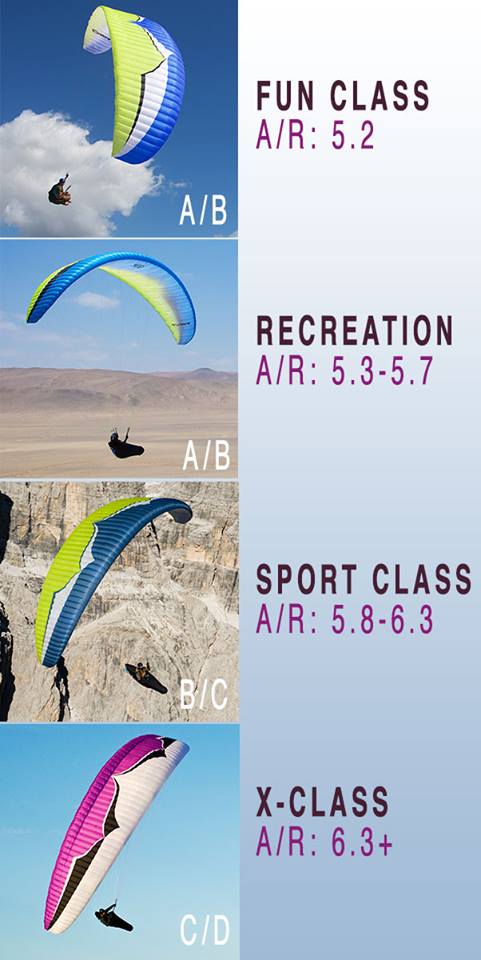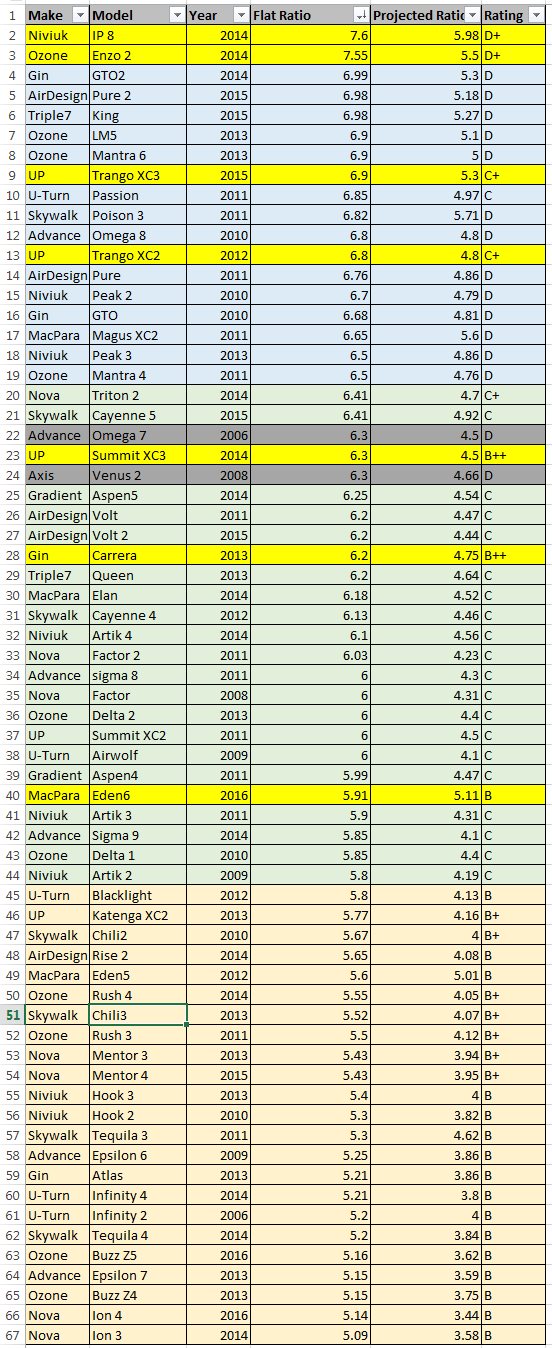2. Problems with Glider Ratings
3. Gaggle Flying
4. Gear Setup
5. Flymaster Setup
6. Flytec 6030 Setup
7. Spot VS Delorme
8. XC Task Clinic
9. GPS Comparison
10. Sprint Tasks
11. DIY Cell Mount
12. DIY Flight Deck
13. DIY Catheter
14. Incidence Reports
15. Creating Waypoints
16. Creating Airspace
17. Resources
18. FTV Explained
19. Downloads
The Problem with Glider Ratings
Years ago when I started paragliding (2006) the DHV ratings seemed to me to be a reliable way to determine a gliders suitability for a pilots skill level. As well it gave an obvious progression from beginner gliders to advanced. If your instruction was similar to mine then you were told not to move up by more than one rating at a time to stay out of trouble. Then in 2010 Ozone released the Mantra R10.2, the worlds first commerical 2 line glider that allowed unprecedented performance in open class gliders. If you weren't flying a 2-liner in world class competitions you were left in the dust. This meant every other manufacturer had to rush to market with their own 2-line design in order to sell any gliders to top pilots. With minimal testing some of these designs were arguably inferior and unsafe.
This leads into the tragedy of July 6th, 2011 at the World Championship in Spain where two pilots died on the same day flying these new 2-liner gliders. There was outcry and finger pointing, some noteable pilots left the comp and in the end the Championship was canceled. The fallout for this event was the end of open class wings, from now on only EN-D certified gliders would be allowed in all PWC and similar events. The result of this decision is still playing out in our sport today unfortunately.
When the open class got killed off the sport ended up with two distinct groups of pilots flying in the same category, world class pilots who want the hottest and fastest ship in the sky and advanced pilots who want to fly fast but managable wings. This created demand for a new type of wing in the EN-D category that I call D+ (Ozone Enzo and Niviuk IcePeak 6 to name a few), D in rating but not truly in spirit. Now you have advanced pilots competing against world level pilots in the same category. So some of these advanced pilots say "Hey, I like having a shot at the podium but my only hope now is to drop down a level." And this whole process repeats with advanced pilots flying in the sport category but wanting the performance of an EN-D in the sport class. You also have manufacturers, which in my opinion, have now learned how to game the certification process to get hotter wings into the same category. Manufacturers that don't do this start to feel pressure to release hotter gliders than they are used for the same category in order to stay competitive. Unfortunately one cheap way to make a higher performance wing is to jack up the aspect ratio. This does produce more performance at the cost of stability, the wings can however pass the ratings tests because of modern developments that improve recovery behaviors.
This last point gets to the heart of my argument (I'm long winded, I know!), but here it is: GLIDER RATINGS DO NOT TEST HANDLING ONLY RECOVERY! This is an incredibly important distinction to understand, most experienced pilots do but a lot of low hours pilots do not. A glider passes a test by recovering from a specific induced collapse input in calm air within certain well defined limits (recovery time, amount of glider turn, etc). It does not test a gliders resistance to collapses or it's stability in turbulent air. So you can have an incredibly twitchy, unstable glider that gets and EN-B because hey, at least it recovers nicely in a controlled environment *cough* Gin Carrera *cough*.
To sum up what this means for us in 2016. We used to easily separate categories of competition by glider rating but the mixing and mudying of those waters has made these categorizaionts less fair then they used to be. Competent pilots are stepping down to lower categories in order to stay competitive and because they have access to higher performance wings with higher safety margins then at any point before. As an organizer for a friendly league I think that another metric over wing rating needs to be used to separate pilots into categories. The best metric I've come up with so far is aspect ratio but I'm in a good crowd as other leagues are beginning to do the same thing like the Laragne Competition in France. So starting for 2016 I'm going to add in aspect ratios as restrictions on divisions as well as EN ratings.
Here is how the Laragne competition is currently dividing their categories. I think their categorizations are a bit too conservative. Over time as technologies increase you will see higher aspect ratio wings that are easier and safer to fly so I believe you need to make at least a small buffer for that. It's not going to be perfect but by adding aspect ratio you help to educate all pilots about the deficiencies of glider ratings

To support some of what I'm saying, here is a quick spreadsheet I made of glider ratings and aspect ratios. I added a + or ++ to the rating if I considered it a cheater glider that deserved to be in a higher category then it's actual rating. A caveat here being that most manufacturers make a low and high end EN-B glider these days so all high end EN-Bs I gave a '+', the '++' rating for those EN-Bs show the true outliers
